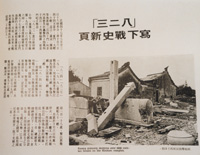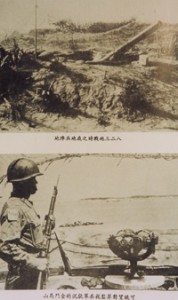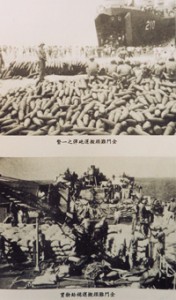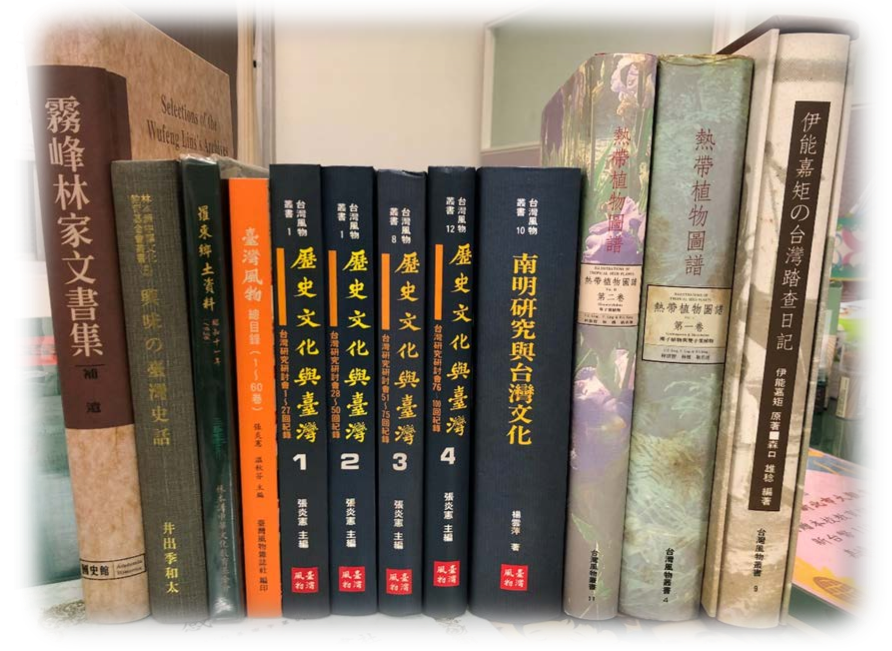 八二三砲戰及其歷史意義
八二三砲戰及其歷史意義
The 823 artillery war and its historical significance
薛化元/Hsueh Hua-yuen
(政大歷史系教授)
(Professor, History Department, National Chengchi University)
2001-08-20
 The artillery shells destroyed over 4,000 houses
The artillery shells destroyed over 4,000 houses
號稱「第二次台海危機」的八二三炮戰在一九五八年八月二十三日下午開打以後,接連著四十四天,中共發射了將近四十八萬顆砲彈。這場戰役發生迄今已經四十三年了,作為捍衛台澎金馬的指標戰役,它在中華民國國軍戰史上是重要的一頁,特別是與古寧頭之役不同,台籍戰士在此戰役中亦扮演重要的角色。然而除了官方的宣傳外,八二三砲戰確實對於以後台灣歷史的發展,台、美、中三角關係的互動,乃至中華人民共和國「解放台灣」的政策都有相當的影響。在八二三炮戰四十三週年前夕,本報「台灣歷史之窗」特別邀請政治大學歷史系薛化元教授執筆,探討這場戰役發生的始末與其代表之歷史意義。
The 823 cannon war, also called the “Second Taiwan Strait Crisis” began on the afternoon of August 23, 1958, and continued for 44 days, during which the PRC launched around 480,000 artillery shells. This battle took place 43 years ago, and was the definitive battle for the defense of Taiwan, Penghu, Kinmen and Matsu, and an important page in the military history of the R.O.C. It was particularly different from the Battle of Kuningtou in that Taiwanese-born soldiers played a major role in this battle. However, apart from official propaganda, the 823 artillery war had a huge influence on the development of Taiwan’s history, the mutual relationships between Taiwan, the U.S. and China, and even on the PRC’s “liberate Taiwan” policies. On the eve of the 43rd anniversary of the 823 artillery war, Taiwan News’ “Window on Taiwan” has been written by Professor Hsueh Hua-yuen of National Chengchi University’s history department, who here looks into the entire story of this battle and its historical significance.
炮戰發生始末
所謂八二三砲戰並非只發生於一天,實際上自一九五八年八月二十三日,中華人民共和國人民解放軍與數百門大砲於當日下午五點三十分同時向大小金門大擔、小擔等島,進行密集性的砲擊起,在短短八十五分鐘內共發射了三萬多發砲彈,砲戰並持續到一九五九年一月七日。總計人民解放軍向金門等地砲擊的數量超過四十萬枚,無論數量或是密度,都在人類戰史上可佔一席之地,由於砲戰始於八月二十三日,史稱「八二三砲戰」,又由於這是一九四九年以後台海第二次大規模的軍事對抗,也有稱為「第二次台海危機」者。
The entire story of the artillery war
What we call the 823 artillery war wasn’t over in a single day. It started at 5:30 p.m. on August 23, 1958, when the People’s Liberation Army (PLA) of the PRC shot several hundred large artillery shells at several islands of Kinmen, including Big Tan and Little Tan, in an intensive artillery attack. In 85 short minutes, they had fired more than 30,000 shells. The artillery battle continued until January 7, 1959. The total number of shells fired at Kinmen and the surrounding areas by the PLA exceeded 400,000, both in number and density a rare record in human history. Since the artillery battle started on August 23, it has been called the “823 artillery battle” [8 standing for August], and also the “Second Taiwan Strait Crisis”, since it was the second large-scale military confrontation to occur in the Taiwan Strait since 1949.
 Up: The people of Kinmen engaging in armed self-defense.
Up: The people of Kinmen engaging in armed self-defense.
Down: The opposite shore can be glimpsed from Kinmen’s Horse Hill
美方支援穩住戰局
砲戰發生之後,為了因應中華人民共和國強烈的攻擊,美國國防部在次日旋即發表第七艦隊在台灣海域進入戰鬥態勢,此後第七艦隊除了協助我國海軍補給團赴金門補給外,並且與空軍、海軍陸戰隊、陸軍舉行一連串防空兩棲作戰聯合演習,並派駐F-104A星式戰鬥機及勝利女神飛彈營至台灣,同時也在台灣成立作戰指揮中心。而為了直接有效壓制來自人民解放軍的持續砲擊,美國軍方並且提供火力強大的新型「巨砲」至金門,果然在其後雙方的砲戰中充分發揮其功效。在美方的協助下,中華民國軍方雖然在八二三砲擊當日遭到嚴重的損失,包括金防部副司令官吉星文中將等殉職,不過終究可以在火力上與人民解放軍抗衡,甚至進而可以壓制其火力。更重要的是,人民解放軍若意圖佔領金門,除了必須在地面強大火力掩護外,也必須取得金門上空取得制空權,才可以遂行兩棲登陸作戰。可是自當年九月起,持續在台海及金門島發生的空戰中,國軍持續取得制空權,並擊落二十多架米格戰鬥機,中華人民共和國明顯地無法取得制空權。由於中華人民共和國不能如原先計畫般佔領金門,而美國方面亦迫使蔣中正總統從金門、馬祖撤軍,使得中華人民共和國在思考如何解決台灣問題上,出現政策上的大轉變,也影響了以後台灣海峽兩岸的互動關係。
U.S. support stabilizes the situation
Following the outbreak of the artillery battle, the U.S. Department of Defense announced the next day that the 7th Fleet in the waters around Taiwan would enter into the battle situation in order to respond to the PRC’s violent attack. After this, in addition to helping the R.O.C.’s navy by deploying regiments to Kinmen, the 7th Fleet, along with the R.O.C. Air Force, Marine Corps and Army, held a series of air defense and amphibious joint battle exercises, and dispatched Lockheed F-104A Starfighters and Nike-Hercules missiles to Taiwan. At the same time, they also set up an operations command center in Taiwan. In order to suppress the continuous shelling from the PLA directly and effectively, the U.S. Forces supplied the new kind of giant artillery shells with greater firepower to Kinmen, and as expected, their efficacy was exploited to the full henceforward in the artillery battle between the two sides. Although the R.O.C. army suffered heavy losses from the shelling on August 23 itself, including the deaths of Kinmen Defense Unit Auxiliary Commanding Officer Lieutenant General Chi Hsing-wen and others, with the assistance provided by the U.S. Forces, it was ultimately able to contend with the PLA in terms of firepower, and then even suppress them. Even more importantly, if the PLA were to try to seize Kinmen, apart from the necessity of strong firepower cover, they would also have to win Kinmen’s airspace and air supremacy before they would be able to launch amphibious landing operations. But from September that year, with continued air combat in the Taiwan Strait and Kinmen, the Nationalist army persisted in holding on to command of the air, and shot down more than 20 MiG fighters, and the PRC was clearly unable to win air supremacy. Since the PRC was unable to capture Kinmen as originally planned, and the U.S. was pressing President Chiang Kai-shek to withdraw troops from Kinmen and Matsu, the PRC was forced to think up a way to resolve the Taiwan problem, and came up with a major change of plan, which affected all mutual interaction across the Taiwan Strait from this point on.
美方的立場與中共高層的政治考量
實際上,在一九五○年代,縱使台灣與美國簽訂了《中美共同防禦條約》,美方對於條約是否及於金門、馬祖等外島,始終沒有明確的表態,而且也提出中華民國政府從金馬撤軍,以營造國府與北京政權的中立地帶,來架構雙方的統治領域與國際定位。而在八二三砲戰發生以後,美國雖然採取一連串積極協助中華民國行動,但是國務卿杜勒斯有意藉此讓中華民國軍隊產生自外島撤軍的意向,最晚在同年九月三十日便已公開提出。此一意見當然不為蔣中正總統所接受,而於十月一日正式公開表示反對自外島撤軍。相對地,中華人民共和國的領導高層,包括毛澤東、周恩來等亦開始認真思考,若是持續過去原有的戰略,繼過去先後攻佔海南島、舟山群島、大陳之後,進而取下金門、馬祖。因為縱使人民解放軍能在這些軍事行動中,順利佔領國軍駐防的中國大陸沿海諸島,則中華民國統治的領土將只剩下台灣本島,在地緣上便與中國大陸完全脫離關係,如此一旦出現美方計畫的國共雙方「跨峽而治」的現象,可能導致台灣獨立的局面。因而中華人民共和國的領導人表示,基於前述政治上考量,就改變原有的政策,決定要不就台、澎、金、馬一起攻下,否則也不各別取下金門、馬祖等外島。此後,人民解放軍宣稱對金門採取「單打雙不打」的策略,實際上卻只呈現戰術上人民解放軍無法施展的事實,而成為一種習慣性的軍事騷擾。
The American position and the political considerations of the PRC’s top echelons
In fact, during the 1950s, even though Taiwan and the U.S. signed the Sino-U.S. Mutual Defense Treaty, the U.S. never explicitly defined whether or not the treaty covered Kinmen, Matsu and other offshore islands, and also suggested that the R.O.C. withdraw troops from Kinmen and Matsu, so as to construct a neutral zone between the Nationalist government and the Beijing regime, and have a framework for the territory governed by either side and international position for both sides. But after the 823 artillery war, although the U.S. adopted a series of actions to help the R.O.C., the U.S. Secretary of State, John Foster Dulles hoped that the battle would force the R.O.C. armed forces to decide to withdraw, and finally on September 30, 1958, he openly suggested it. This suggestion was obviously not going to be accepted by President Chiang Kai-shek, and on October 1, Chiang formally expressed his opposition to withdrawing from the offshore islands. On the contrary, the upper echelons of the PRC leadership, including Mao Zedong, Zhou Enlai and others, began to do some serious thinking. If they persisted with their original strategy, then following attack and occupation of Hainan Island, the Zhoushan Islands and the Dachen Islands, they could go on to take Kinmen and Matsu. Because if the PLA could, by these military operations, smoothly seize all the islands along the mainland coast that were garrisoned by the Nationalist army, the only remaining territory governed by the R.O.C. would be the island of Taiwan itself, which has absolutely no geographical relationship with mainland China. In this way, once the U.S. plan of Nationalist and Communist governments each ruling one side of the Strait emerged, it might lead to a situation of Taiwanese independence. Consequently, the leaders of the PRC announced that, based on the above-mentioned political considerations, they were changing their original policies and had decided that if they didn’t attack Taiwan, Penghu, Kinmen and Matsu all together, then they wouldn’t take Kinmen and Matsu separately. Henceforward, the PLA declared that they were adopting a strategy of attacking Kinmen on odd-numbered days, and resting on even-numbered days, but actually, they were simply displaying the fact that it was tactically impossible for the PLA to bring their full abilities into play, and it became a habitual military annoyance.
 Up: Artillery shells being transported on a beach in Kinmen.
Up: Artillery shells being transported on a beach in Kinmen.
Down: Disembarking from ships bringing supplies to Kinmen.
當然,前述現象的形成,一方面固然可能是中華人民共和國領導高層,思考國際情勢的改變,而提出所謂「不再取下金門、馬祖」的政策。但根據當時的資料顯示,人民解放軍可能也已經無力佔領金門。所以,中華人民共和國的官方說法,似乎也有意忽略其軍事力量不足的問題。實際上在美國政府支持下的中華民國政府,在國軍制空權的取得乃至砲兵的火力戰方面,事實上已經使人民解放軍無太多施展的空間。
Obviously, the appearance of the aforementioned phenomenon, may in one aspect have been due to the higher echelon leaders of the PRC deliberating the changes in the international situation and coming up with what they called the “no longer take Kinmen and Matsu” policy. But contemporary papers show that the PLA may already have been lacking the strength to occupy Kinmen. So the PRC’s official line seemingly deliberately overlooked the problem of insufficient military strength. Actually, with the support of the U.S. government, the Nationalist army had air supremacy and was also in control of the artillery battle, and so the R.O.C. government was already able to prevent the PLA from using its abilities to the full.
雙方由軍事戰場轉移至國際政治舞台
無論如何,由於八二三砲戰以後,中華人民共和國已經放棄逐一攻佔沿海島嶼的計畫,因此台灣海峽的形勢,實際上已經固定為冷戰的軍事對峙局面,欲以戰爭形式消滅對方,基本上已不具可行性。因此,縱使發生武裝衝突,也只是零星的事件,雙方的主要對抗戰場實際上已轉移到國際政治舞台,這當然是八二三砲戰以來,中華人民共和國高層所使料未及。在另一方面,當年十月二十三日美國國務卿杜勒斯與蔣中正總統發表聯合公報,雖然提及金門、馬祖等外島的防衛問題,另外也正式提出反對以武力主動反攻大陸的可能,這也影響了台灣國內政治局勢的發展。既然武力反攻大陸也欠缺足夠的空間與邏輯上的可能性,則要求政府在台灣加強落實民主、法治的訴求便較過去積極,包括立法委員齊世英提出要求採取精兵政策,或是省議員李萬居在省議會的總質詢中要求立法委員全面改選,皆是與此一歷史發展有關。至於當時自由派的代表雜誌《自由中國》不僅更加明確主張:國民黨主政下的政府延續過去以武力反攻大陸的可能已然降低。因此在武力「反攻大陸」幾無可能的前提下,更積極促進台灣自由、民主的追求,這也是八二三砲戰對台灣政治所產生的意外影響吧。
R.O.C. and PRC move from military battleground to the international political stage
At any rate, after the 823 artillery battle, the PRC abandoned the plan of attacking and occupying the coastal islands one by one, and as a result, the situation in the Taiwan Strait began to stabilize for the cold war military face-off. It was basically already an impossibility to want to use hostilities to wipe out the enemy. Consequently, even if there had been armed conflict, it would have been only a random incident, and the important battlefield on which they competed had already moved to the international political stage. This of course was not what the upper echelons of the PRC had expected after the 823 artillery battle. On the other hand, on October 23 that year, the U.S. Secretary of State, John Foster Dulles, and President Chiang Kai-shek released a joint communique, and although it mentioned the defense issues of Kinmen, Matsu and other offshore islands, it also formally brought up opposition to the possibility of an unprovoked armed counterattack on the mainland, and this influenced the development of Taiwan’s domestic political situation. Since they it was impossible in terms of space and of logic to launch an armed counterattack on the mainland, people in Taiwan demanded that the government do more to implement the democracy and law and order that was needed. Among those making these demands was the legislator Chi Shih-ying, who raised a request to use the crack troops policy, and also a member of the Provincial Assembly, Lee Wan-chu, who during the Assembly’s general question time requested wholesale re-election of all the legislators; all of these things were connected to this historical development. As regards the magazine of the freedom faction of those days, “Free China,” not only did it argue its case even more unequivocally than before: the possibility for the government under the KMT administration to continue the policy of an armed counterattack on the mainland was already receding. Consequently, with the premise of counterattack almost impossible, demands from the people of Taiwan to step up freedom and democracy were stepped up, and this too turned out to be an unexpected legacy of the 823 artillery war on Taiwan’s politics.
Edited by Tina Lee/ translated by Elizabeth Hoile
李美儀編輯/何麗薩翻譯









